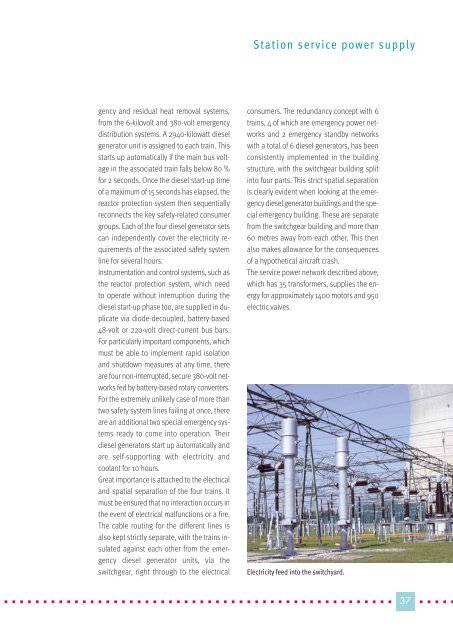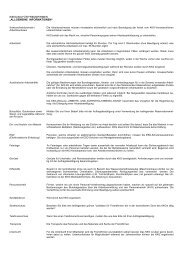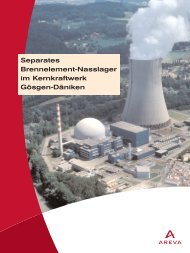Technology and Operation - Kernkraftwerk Gösgen
Technology and Operation - Kernkraftwerk Gösgen
Technology and Operation - Kernkraftwerk Gösgen
You also want an ePaper? Increase the reach of your titles
YUMPU automatically turns print PDFs into web optimized ePapers that Google loves.
gency <strong>and</strong> residual heat removal systems,<br />
from the 6-kilovolt <strong>and</strong> 380-volt emergency<br />
distribution systems. A 2940-kilowatt diesel<br />
generator unit is assigned to each train. This<br />
starts up automatically if the main bus voltage<br />
in the associated train falls below 80 %<br />
for 2 seconds. Once the diesel start-up time<br />
of a maximum of 15 seconds has elapsed, the<br />
reactor protection system then sequentially<br />
reconnects the key safety-related consumer<br />
groups. Each of the four diesel generator sets<br />
can independently cover the electricity requirements<br />
of the associated safety system<br />
line for several hours.<br />
Instrumentation <strong>and</strong> control systems, such as<br />
the reactor protection system, which need<br />
to operate without interruption during the<br />
diesel start-up phase too, are supplied in duplicate<br />
via diode-decoupled, battery-based<br />
48-volt or 220-volt direct-current bus bars.<br />
For particularly important components, which<br />
must be able to implement rapid isolation<br />
<strong>and</strong> shutdown measures at any time, there<br />
are four non-interrupted, secure 380-volt networks<br />
fed by battery-based rotary converters.<br />
For the extremely unlikely case of more than<br />
two safety system lines failing at once, there<br />
are an additional two special emergency systems<br />
ready to come into operation. Their<br />
diesel generators start up automatically <strong>and</strong><br />
are self-supporting with electricity <strong>and</strong><br />
coolant for 10 hours.<br />
Great importance is attached to the electrical<br />
<strong>and</strong> spatial separation of the four trains. It<br />
must be ensured that no interaction occurs in<br />
the event of electrical malfunctions or a fire.<br />
The cable routing for the different lines is<br />
also kept strictly separate, with the trains insulated<br />
against each other from the emergency<br />
diesel generator units, via the<br />
switchgear, right through to the electrical<br />
Station service power supply<br />
consumers. The redundancy concept with 6<br />
trains, 4 of which are emergency power networks<br />
<strong>and</strong> 2 emergency st<strong>and</strong>by networks<br />
with a total of 6 diesel generators, has been<br />
consistently implemented in the building<br />
structure, with the switchgear building split<br />
into four parts. This strict spatial separation<br />
is clearly evident when looking at the emergency<br />
diesel generator buildings <strong>and</strong> the special<br />
emergency building. These are separate<br />
from the switchgear building <strong>and</strong> more than<br />
60 metres away from each other. This then<br />
also makes allowance for the consequences<br />
of a hypothetical aircraft crash.<br />
The service power network described above,<br />
which has 35 transformers, supplies the energy<br />
for approximately 1400 motors <strong>and</strong> 950<br />
electric valves.<br />
Electricity feed into the switchyard.<br />
� � � � � � � � � � � � � � � � � � � � � � � � � � � � � � � � � � � � � � � � � � � � � � � � � � �37 � � � � � � �




